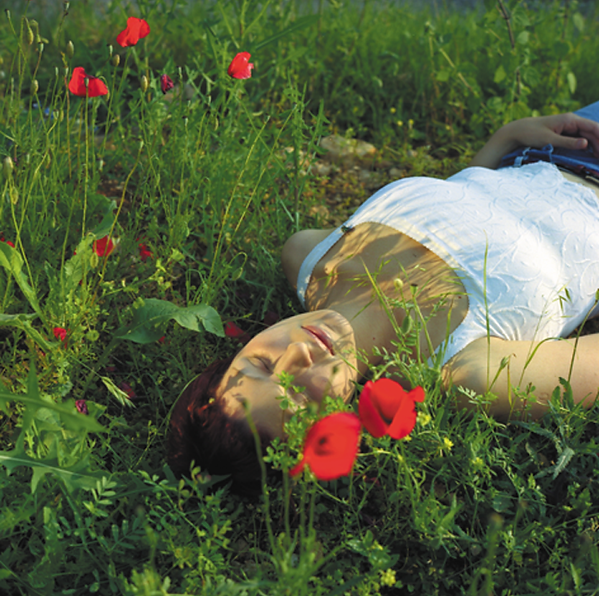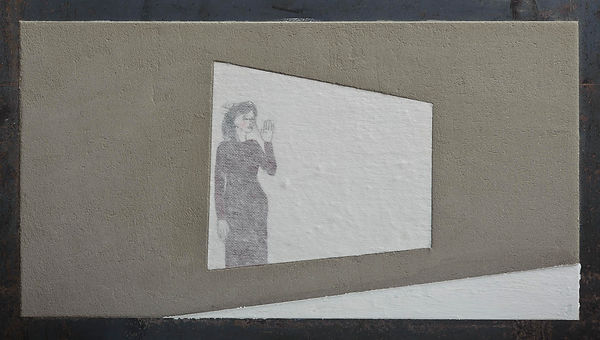The Line of Sight
by Thordis Adalsteinsdottir, Emanuele Becheri, Adrian Paci, Renata Poljak, Giada Giulia Pucci, Moira Ricci, Jelena Tomašević, ZAPRUDER Filmmakersgroup

ON VIEW AT RITA URSO ARTOPIA GALLERY
DECEMBER 14 - FEBRUARY 12, 2021
The gaze of portrait looks at nothing, and looks at nothingness.
Jean-Luc Nancy, in "Le Regard du portrait"
The exhibition presents a selection of works already shown in the gallery since 2001, gathering them around the theme of gaze.
It is the gaze that "exposes" the subject in painting and presents it to our eyes, revealing the invisible.
Its implications refer not only to the relationship between the artwork and the observer, between what is looked at and who is looking at it, but also to the creative process itself and the making of work of art.
TITLE
In the exhibition space all gazes of the works sink into our eyes and always remain relevant in a continuum of visual relationships, hence the title of the exhibition. The viewer finds himself ideally enveloped and observed, almost scrutinized. The mechanism that emerges is a mutual exchange, a dynamic that runs on different temporal levels and provides a device for reflecting on the contemporary world and art itself.
ARTWORKS

Gauguin's wide-open eyes open onto ours. The temporal dimension called into question is the dreamlike one that stimulates a deep state of melancholy and instability of the self. The figure is imprisoned on a flat surface, in absence of perspective, because it is abundantly covered with bright paint. At the same time the harmonious flower patterns, in which the body seems to be immersed, indicate a redeeming dimension, and therefore a possibility of happiness and rebirth.
Thordis Adalsteindottir, Gauguin, 2010, acrylic on canvas, 48x58 cm
Her themes in an oblique way imply cycles of life, death, and rebirth through an iconography of human and fairy-tale animal imagery. [...] Thordis never uses a ready-made popular image; her depictions are always stylized from her own imagination - memory and dreams alike.
(Jovana Stokic, for the exhibition Have No Fear, Artopia gallery, Milan - February 2010)

Alice Or Where I Am Not Afraid refers to a dreamlike fantasy: the artist is self-represented with closed eyes, perhaps asleep, lying on a field of red poppies. Here, a state of uncertainty and disorientation in front of the reality of Croatian society and communism are merged, with an awareness mixed with the desire to go further.
Renata Poljak, Alice Or Where I Am Not Afraid, 2002, colour photography laminated on aluminium dibond, 100x100 cm, 3 copies + 1 ap
Her formal approach, between the personal narration and the documentary, is a condition of necessity in which her experiences and her point of view give form to movies and videos belonging to the documentary form and genre [...] Since political contents need to assume a political form in her work, such contents find in the documentary their (and obvious) context. Her necessity to analyze and watch the world through the video-camera spawns the reflection about our society, about socialism, about Tito, about belief, about monuments…
(Francesca di Nardo, in an interview for the exhibition I need you to believe in something, Artopia gallery, Milan - March 2009)

Jelena Tomašević, Life Interest, 2008, mixed media on steel, 30x50 cm on 3 mm steel plate
The present prevails motionlessly in Life Interest. The time appears suspended in the gaze of a woman oppressed against a large window, representing the impossibility of realizing herself in a world where stereotypes prevail, a black and white reality deprived of any emotional element. The painting seems to burst into an everyday life scene where places of affection overturn in mental prisons, difficulties and psychic disquiets, small and big violence that upset daily serenity of domestic menage.
Color emerges only as a sign of absence – the absence of abundance of color surfaces. This scarcity of color allows the viewer to project his/her own anxiety. At the same time, it provokes the viewer’s desire to overcome violence and find meaning in existence. This is indeed the highest achievement of Jelena’s paintings: a possibility of giving us insight into the life that is hidden behind banality. [...] This expansion into the viewer’s space underlines the importance of the act of viewing and instigates active participation.
(Jovana Stokic, in "Jelena Tomasevic’s Paintings on Steel, or The Imitation of Life" for the exhibition Apparent Servitude, Artopia gallery, Milan - October 2010)
Moira Ricci weaves present and past. She intrudes into old photographs of her mother to indelibly imprint her presence even in a time that has not been shared. The artist’s eyes observe her, inquisitive but affectionate. With a brave look willing to put into play her own emotionality, she generates a mirror effect in the viewer of her work: it is an act of love towards her mother, a form of elaboration of loss, which however takes further strength from the radical questioning of the relationships between the viewer and the object of the gaze.
At the heart of her interests is the world of family affections, family home as a natural theater of these relationships. With a brave gaze, willing to put into play her own emotionality, the artist realized some works starting from visual materials shot in a family setting, leaving its spontaneous beauty untouched but reorganizing it to add new reading levels. First of all the mirroring effect that her works arise in the viewers, the ability to transform the story of the self in a breeding ground to start a consideration on our world, the affects and places that, for better or for worse, create the identity of everyone.
(Emanuela De Cecco, for the exhibition Interfuit, Artopia gallery, Milan - March 2006)
The smiling couples, taken according to a "happy family" cliché, which Adrian Paci pictorially immortalizes, seem not to look directly at the viewer. Their eyes, set, are probably directed towards the lens of a camera. Those faces have already lost their individual identity and what counts to them is the new identity of the couple, which the photographer tries to fix. With simplicity, the artist is addressing the collective power that social gaze has, expressing an ambiguous attitude that first seduces the spectator to enter a sort of private album of memories and then prevents him from penetrating it through placing an ideal model in front of him.
The work of Adrian Paci has a lot to do with tracing a sort of identity of the being, searching through it’s specific layers. Using fairy tales and memories he defines an introspective search towards the surroundings. It’s not a mere coincidence though the artist’s choice of such a traditional medium as painting. It stands as a perfect materialization of the ambiguity of the feeling he wants to transmit to the viewer.
(Edi Muka, in "Happy People" for the exhibition Home sweet home, Artopia gallery, Milan - October 2001)
The present is also connected to the Emanuele Becheri's gaze that, powerfully directed to the viewer, seems to reveal the dimension of the genesis of his work. Drawings become the condition in which the figures can accomplish and define their world. The artist self-portraits himself in bizarre ways, experimenting with different disguises, mutilated, helped by sticks that serve to maintain his fragile balance in an upturned world, and laying bare his own condition as an irreverent marionette that laugh at themselves and at their audience, to show the artist’s infinite potential for metamorphosis.
The disablement and repeated morphological monstrosity of the figures is redolent of the
Latin mostrum, the monster as a sudden manifestation of an epiphanic, divine aspect. The artist sets out to unveil a new reality, a space that is other [...].
(Paola Caravati, in the catalogue for the exhibition Va, pensiero... - Artopia gallery, Milan - May 2015)
The enigmatic and disquieting gaze, presented by ZAPRUDER Filmmakersgroup provides a reflection internal to their artistic and cinematographic practice, on the consequences of a stratigraphic conception of time, often made of overlaps rather than scrolling. The cross-eyed, lateral gaze, on the one hand, fragments the vision by dividing it into two points of view, on the other, subtracts from it the perspective encounter that allows a deep dimension, typical of 3D cinema.
Amplifying the boundaries of vision, within a hypnotic and alienating environment, seems to be a constant in the work of ZAPRUDER filmmakersgroup. [...] It unifies the two different angles, leaving us once again with that shade of mystery and a sense of joyous defeat over the elusive status of the image. [...] With the mirroring and duplication of points of view, in this "partial" place, in the middle, forced to the imagination, the exhibition explicitly demands the completion of the viewer's vision.
(Cecilia Ermini, for Il Manifesto in an article about the exhibition Fault - Artopia gallery, Milan - October 2015)
Giada Giulia Pucci represents a timeless, absolute, primitive look. A witness to the memory of the past but also a documentation of the future. The scraps found in the street with which she dresses and protects herself become symbols of humanity, her gaze is similar to that of all peoples of all times and records all the existing worlds. It is an instrument for survival because, abstracted from the context, it analyses reality and extends beyond it, towards nothingness, towards the end of the world.


Giada Giulia Pucci, Umano. Vestizioni al suk di Torino, 4/10/20, performance with waste material, objects and clothes abandoned at the end of the market, 2020, digital printing on professional photo paper, 50x70 cm each, ed. 3 + 1 ap
Gaze as an analysis of reality. Perhaps now the eye (of the artist) no longer sees what is missing in the world to be a painting but sees reality which is already a painting itself!
Maybe by now everything is already revealed, there is no need for an artifice to reveal it, there is a need to teach to see everything in its complexity. Because the complexity of reality is beauty and absolute.
So the gaze, the analysis of looking and feeling, must only be exercised to see art even where it apparently does not exist.
(Giada Giulia Pucci, in some reflections for this exhibition)
The eyes of the works on show are reflected in ours and introduce a plurality of possible timelines and worlds. The reciprocity intrinsic to the act of seeing therefore constitutes not only an encouragement to know and to become aware of the reality that surrounds us, but also to resist the difficulties of dark moments, such as we are experiencing, also thanks to the support that those gazes around us can provide.








